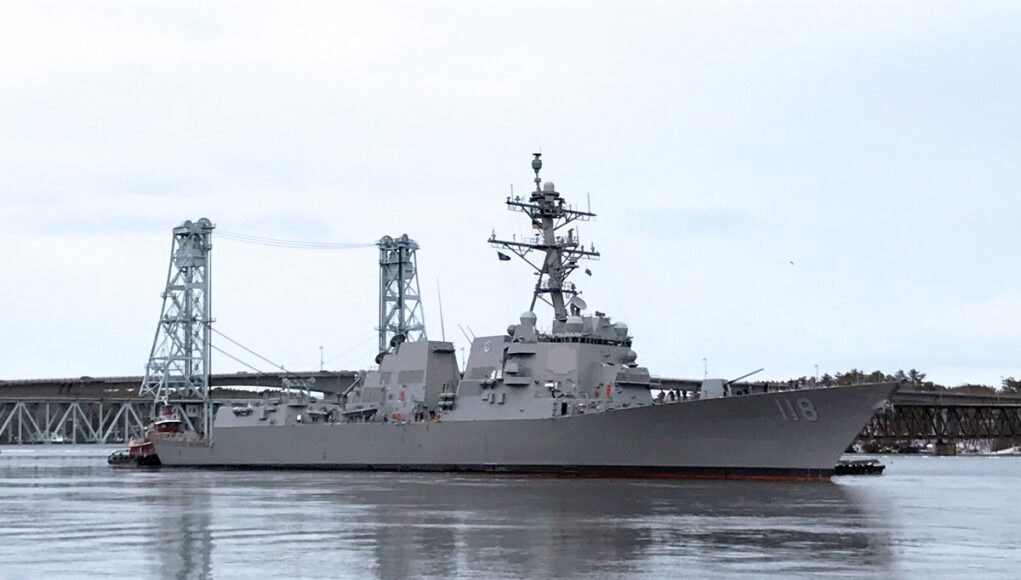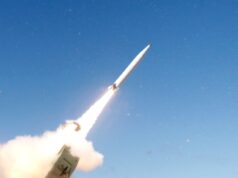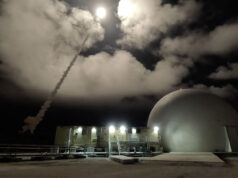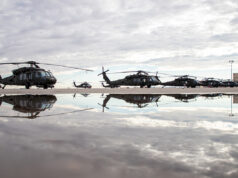The U.S Navy has accepted delivery of the guided missile destroyer USS Daniel Inouye from shipbuilder General Dynamics Bath Iron Works.
According to the U.S. Navy here, delivery of DDG 118 represents the official transfer of the ship from the shipbuilder to the U.S. Navy.
“The future USS Daniel Inouye is named in honor of Daniel Inouye, who served as a United States Senator for Hawaii from 1963 until his death in 2012. He received the Medal of Honor June 21, 2000 for his extraordinary heroism in action while serving with the 442nd Infantry Regimental Combat Team in Italy during World War II.”
Prior to delivery, the ship successfully conducted a series of at-sea and pier-side trials to demonstrate its material and operational readiness.
DDG 118 is a Flight IIA destroyer equipped with Aegis Baseline 9, which the U.S. Navy say provides improved “Integrated Air and Missile Defence capabilities, increased computing power, and radar upgrades that improve detection range and reaction time against modern air warfare and Ballistic Missile Defense threats”.
Also in production are the future Arleigh Burke-class destroyers Carl M. Levin (DDG 120), John Basilone (DDG 122), Harvey C. Barnum (DDG 124), Patrick Gallagher (DDG 127), and Flight III ships, Louis H. Wilson, Jr. (DDG 126), and William Charette (DDG 130), as well as the future Zumwalt-class destroyer, Lyndon B. Johnson (DDG 1002).
As one of the Defense Department’s largest acquisition organizations, PEO Ships is responsible for executing the development and procurement of all destroyers, amphibious ships, special mission and support ships, and boats and craft.










Deeply jealous of the USN 🙁
U.S. seamen are deeply jealous of the R.N……..We have beer!
and they have all been or currently being vaccinated
Error. No. And I know this because I work closely with the USN.
Me too and they TOLD me they are vaccinating them
The USN guys I have spoken to are still to get their jabs. Some thing like 1/3 of the USN has declined the jab. That said the RN is pushing hard to get ships crews jabbed just to save on the pain in the arse covid precautions that are affecting Operational Capability.
Over the past year RN ships are doing far better on Covid precautions than the USN. I have never been kicked off an RN or RFA vessel for a covid outbreak reason where as it seems to be a near weekly occurance in the USN
Sadly, sensible precautions like mask wearing and getting vaccinated are a politically charged issue in the US. It is also complicated by appalling historical medical practices wrt to African Americans, leading to distrust. I suspect both have impacted the US military, leading to more issues as you previously observed.
Ian wrote:
As a very young Sapper and a Combat Support Boat operator , I used to get tasked to carry out to any visiting Navy Ship in Stanley Harbour their beer run, and as my reward I would always receive a crate of beer. The Marines would furnish us (The CSB det) with Rum, The RAF (other than the rock-apes) simply looked down on us and refused to acknowledge our existence and the Army, well they would simply give us the finger as they drove past in the poring rain, then when they demanded a lift out to their billets would point at their cap badges and state we wore the same badges, Which is why we used to send them towards the RCT Kiwi which ran a taxis service. Oh what joy.
Just imagine if the RN had decided to replace T22, T23 & T42 all with a steady drum beat of Arleigh Burke’s. How many would we have by now? How much would we have saved from constantly developing ships for limited production runs?
None. They are probably expensive to run.
And our national shipping building industry would be none existent.
No, we could have built them here.
Building Sombody else’s design is not the same as designing our own from scratch. No technology innovation or design skills. it would just be a production line.
Part of our defence budget is to develop new equipment to export if we don’t design and build.
Too manpower intensive, they have a crew somewhere north of 300 people!
Well we’d have saved a bundle of cash not developing T45 & T26. Spend the cash on more jobs for sailors.
Won’t argue with that Rob, unfortunately, we just can’t match that sort of manpower requirement. Nice thought though!
The latest AB’s are nearly $2 Billion each.
Much more then T45 and T26.
They are not all they are cracked up to be….
So would you rather have the RN have 6 x T45, 8 x T26 & 5 x T31
or
25+ Arleigh Burke’s, with Tomahawk & LSRAM?
They don’t have Lsram.
Most only have a limited number of land attack tomahawk
They are really really crap at Asw and they are not as good at AAW as a T45.
So noting the split between Pacific and Atlantic fleets… I would take the RN mix.
Why do you think the USN is going for an Asw centric FREMM frigate. And let’s not even start on the cost of that project after they have added the Made In America clauses to the build spec. It will end up less capable and more expensive than a T26
cheers for the input Gunbuster . I’m keen to see how the flight 111 AB variance will stack up vs Type 45 in AAW. No doubt this will be a leap forward. Dead right on the type 26 frig, The Yanks should have differed their decision to evaluate the type 26 – missed chance in my view
Ah, I see you have.
Hard to believe the AAW/T45 comment, but I recognise there have been several occasions a T45 has been drafted into a USN CBG in the past decade, so there must be something in it…
Again look up the cost of a AB is double the cost of a T45. Even with a exchange rate it’s poor value
Can you be specific ? Arleigh Burkes, especially the IIAs onwards, appear to my eyes to be everything a blue-water navy could dream of
USN. Loves the type 45. Different ideas different class. Just having 20 doesn’t mean better
Build cost for a AB is double the cost of a type 45. So I would say less
I would have preferred to keep the Type 23 in Low Rate Production, with Incremental Improvements spread over each Ship, probably wouldn’t be that far removed from what a Type 26 offers today. As New Ships enter the Fleet the Oldest ones could be passed on to Allies.
T23 is cramped and lacks nearly all the things you need for AAW including generating and cooling capacity plus stability for larger/higher radars. The later ships were evolved from the earlier ones are are notably better in numerous (but non sexy) aspects such as internal layout. Hence why the very oldest were sold off to Chile.
T45 has a very different hull form to accomodate large VLS, as does AB, which is counter to the needs for quietening.
As for ABs vs our fleet, we’d be lucky to have afforded the purchase of 8 AB for 6 T45 and 13 frigates. Not to mention the crewing requirement at over double that of a T23.
As ever running costs are more improtant than up front purchase – and the T23s spend most of the time on diesals vs ABs always on GTs. That is an order of magnitude level cost advantage.
The Type 23 as designed is Short of Space compared to the Type 45,but keeping it ASW/GP with the Ability to Evolve it’s Design to maybe increase it’s Size by say 1-1.5 k Displacement surely gives it the Capability to stay Relavent, keeps Design Skills going and importantly keeps the Shipyard (s) in Vital Work.
No, no it doesnt.
Keeping design skills going is not acheived by building the same thing for ever even if you just “make it bigger”.
Keeping the design skills means doing as we did/do with successive generations of ship design.
Keeping the yards busy is about orders which is about fleet size. The worst thing for the yards is to just build the same or slightly different thing as they’ll never evolve or upgrade, its easy for them shirt term, but disastrous long term.
T23 to 45 to 26/31 is evolution of design and build.
T23 to 23+ to 23++ is a dead end.
There has to be a Middle Way – Evolution from a T23 to a T26 is all well and good, but when you can’t get the Government Funding to Build the Numbers you need, and you can’t Buy the Weapons you want to Equip them with, you just get stuck in a Vicious Circle
A ship is dependent on the beem size as to how much top weight that can be carried.
You would need to increase the beem size to give an updated T23 the ability to accommodate a lot more top weight and stability. You might as well design a new ship!
May 2018 build begins -> March 2021 fulled equipped and commissioned.
What is it that they are doing that MOD / BAE is not? HMS Glasgow was started in July 2017 …she is still in pieces
MoD / Treasury annualised spend rate limits…
However, if the MoD could get it equipment programme managed effectively i.e. make decision (especially around the initial requirements) and stick to them, they could possibly speed up the process. This would allow them to run programmes in series rather than trying to run lots of late running programmes in parallel, reducing in year spend rates and project procurment costs. Big problem – sticking to requirements…
Cheers CR
Hence the importance of T31’s fixed costs model.
Never happen. UKGOVS contract is a paperwork exercise complainant doesn’t mean It will work and need a variation order
Hi Jon,
Yup, the current system was undermined sometime ago and is in effect a toothless wonder. When I was in procurement (techie / analyst) I was present on rare occasions when I saw some jaw dropping kick the can down the road decisions. I knew then that the equipment procurement programme was heading to hell in a hand cart. Sad.
CR
Hi Supportive Bloke,
I often flag that up. I’d make it the normal contracting mechanism. Any deviatation would require serious justification and I would make it very very difficult to jump through the hoops. UOR would, of course, be treated seperately (lots of different issues in that box!).
If you properly fixed the initial requirements / contracts you could get each batch into service in a reliably quicker timescale (assuming you did not do a T26 snail spend job!). This could put you on a virtuous circle reducing costs.
I would also stipulate a flexible appraoch to the design of ALL platforms to facilitate maintenance, obsolescence management and enable future upgrades. The latter being the sensible manifestation of fit-for-not-with i.e. if it is not ready for the first batch it can go on the next batch if it is ready and then be fitted during routine maintenance cycles. Ships, aircraft and vehicles all included in the approach.
No more delaying major projects because someone thinks that some new mega widget is an absolute must. We didn’t stop building escorts in WW2 while we waited for the new fangled RDF sets to come along..! grr!
Sorry gets me everytime…
Cheers CR
Its the key reason why we will see some cuts. The porcurement budget gets eaten up in operational costs, so the MoD slows down procurment to balance books in short term – that drives up unit costs and also slows down aquistion – which results in an accrual of obsolecent equipment, as we have seen with the surface fleet, submarines, armour, artillery, awacs and fast jets etc.
The answer is to make operational costs such that they don’t eat into procurement budgets. Then we get shorter build times, more bang for our buck and reverse the spiral into obsolescence. For that reason expect to see a lot of old kit go – its expensive to maintain and operate, upgrades only add a few years and is mostly sub-optimal for the modern battlespace. Some are museum pieces – i.e. light gun.
We should demand faster, cheaper procurment of fully combat ready kit – no more ‘fitted for but not with’ in exchange. .Adding squadrons of tranche 1 Typhoon, uparmed OPVs or light infantry battalions with jack more than tired out landrovers and Iraq-war vintage MRAPS is a false economy. They are paper units that will not ever be used except to make the numbers look better.
We need to face up to the capabilites of Russian and Chinese A2AD. Look at our key weknesses in long range fires, area denial / air defence, antisubmarine warfare, and defending and attacking in the information, space and cyber domains.
I am more worried about rogue countries like Iran who are coming on leaps and bounds in Ballistic and anti-ship missile tech, They recently reverse engineered the S300 Air defence system and are currently building a 6000-ton destroyer which will carry their supersonic ‘Persian Gulf’ AShm.
The S300 ain’t that good. It’s old tech. Heck we fingerprinted it’s electronic signature in 1999 when Turkey deployed it on Cyprus.
S400 is now no doubt the same… Israel and Coalition aircraft have tickled it ple ty of times in Syria to get its perameters.
Good to know.
The S400 also seems to have an IFF problem. Israeli F16s tricked a battery in Syria to fire on their own Patrol aircraft. Resulting on a Russian blue on blue incident. The S400 doesnt seem all that great to me. Just typical Russian bluster Sukhoi Su35 better then Eurofighter (nope) S400 able to target stealth. (To be proven) T14 Aramata best MBT in the world. Let’s see. They only have a few dozen in service and have never put them in harm’s way to test the bloody things in a combat situation.
Sweaty socks all pissed on cheap whiskey and shellfish and dreaming of FREEDOM. Just joking
The first T26, is nearly structurally finished.
Interesting 3 masted design.
OK… As someone who has had to work and do maintenance on ABs of various flights and Ticos let’s just say we dodged a big bullet by not going down that route.
T45 is streets ahead in capability and technology. The Machinery spaces on ABs are reminiscent of B3 T42s.
The weapon systems… Where to start… AEGIS… is a combat sytem that does pretty much the same as a T45. The SPY radar is not an AESA radar. The USN are just about to field an AESA radar on ABs using SPY 6 which will give them the same capability that the T45 has had for over a decade.
Missile engagement is mostly using Standard semi active homers that require 2 missiles per target They also require the ship to illuminate the target using trackers… We stopped doing that when we got rid of T42s.
ASW?… ABSOLUTELY CRAP… they would be lucky to find anything with the tail although most have now had it removed. They use a 1960s era torpedo with upgrade electronics that cannot keep up with a modern sub and cannot go deep to hit a sub.
ASuW? The Flight 1 have harpoon but only a flight deck and no hangar. Flight 2 and 3 have a hangar but no harpoon. VLS Mk 41 is just now going to get the latest Tomahawk that has a duel land attack and antiship capabilty.
There is no margin left on the design and they are maxed out on weapons and systems fit’s.
In short the grass ain’t greener across the pond.
interesting and informed commentary GB – thank you
You forgot to mention that the AEGIS is a system that is continually upgraded with baseline 9 supporting air and abm capability. I’m sure you also know that baseline 10 is schedule for IOC in 2023. In terms of radar performance, unless you are privy to confidential radar performance, there is no open source info available to support your claim that the SPY 6 will have the same capability as the T45. It’s a laughable claim that all the resources poured into the development of spy 6 using today’s tech will somehow only bring it up to the performance of a radar system over a decade old and not surpass it.
My point is that SPY 6 will bring the USN up to the same position that the RN has been in for over a decade. That is using an AESA radar and not a PESA as the current versions of SPY radars are.
All command systems get upgrades. So whilst Version 9 is well ahead of the original versions, the same is also true for RN command systems.
Modern command systems are built in software blocks. Changes to hardware such as radar upgrades affecting its performance are more easily accommodated in the command system. It used to be a huge issue to change any of the radars, sonar, weapon systems as it would require a complete software rewrite. Now you change the block that is affected.
Incremental changes are far better than wholesale changes.
Found the cost comparison. Strange as well
To be fail, the US is transitioning to active seeker heads with the Standard missiles plus increasing the range and who know what exactly they really have as they keep everything close as they release info about a weapon system long after its usually been in service
Really flogging the horse with the ab ain’t they, the numbers are great but in reality apart from protecting their carriers from aaw they’re not that great. The inability of the world’s superpower to design a new destroyer will cost them dearly in conflict with China.
Really need to focus on ASW, more subs and more offensive firepower and that goes for the UK as well. Both nations surface fleets are almost completely defensive in nature with nothing of note to hit back with
Good point
The new proposed Constellation class frigates have a drive train like the RN T23s, so are suitable for ASW role.
I read somewhere (in the US defence press if I remember rightly) that when the USN team went onboard the European frigates that they were considering for their new FFG they were very impressed that they did not need ear defenders in the engine spaces because of the considerable effort that had gone into accoustic suppression for ASW ops… I was a little surprised to read of their surprise, if you follow me?
Cheers CR
Here is an US journalist review of FREMM
https://www.defensenews.com/naval/2018/05/30/we-spent-3-days-on-a-top-ffgx-contender-heres-what-you-need-to-know/
It is very quiet. Compared with the Ticonderoga-class cruisers and Arleigh Burkes, there is just very little in the way of ambient noise, and there is almost no noise in the berthings. Even the engine room is quiet enough that hearing protection is not required to enter.
AB propulsion are obsolescent. the ship has a short effective range slighty over 4000nm forcing USN to use more replenishment ships than should be necessary..
Thanks for the link I think that was the article I read…
The FREMM looks really cool tied alongside in Baltimore. That bridge / mast structure reminds me of the old battleship tower bridge structures…
Cheers CR
Yeah, it has even of a pagoda mast feel to it.
Look very dated compared to over navies
Yes, the LCS and DDG1000 diversions really cost the USN a modern ship.
The parallels with the 1960s RN between LCS and Type 19 etc plus DDG100 and T82 seem quite stark.
I had to look up the Type 19 Rogbob.
Sounds like an interesting project, although I think they got carried away with the requirements of the moment as one of the snippets I read suggested that the 40kn requirement was to deal with small fast boats being used by Indonesia during the Indonesia Confrontation. Later version of the T19 had a requirement of 30kn.
Cheers CR
Yeah, there was a lot of to’ing and fro’ing of designs (see Freidman’s British Frigates and Destroyers) but the driver of (very) high speed for what we’d now call littoral ops was the exact same logic as LCS, the RN just didn’t have the resources to do it.
Likewise T82 as a superlative boundary pushing large surface combatant but the exorbitant cost and lack of key capbilities (aviation for it) made it a dead end – a striking similarity to DDG1000.
The RN thus kept building the aged Leander class for a bit longer before a new generation of ships T21/22/42 arrived – all rather less ambitious. The USN keeping AB line going seems comparable there.
That the RN also ditched large carriers (and the USN again considering its carrier strategy) could chime even further.
Of course all this signified the RN moving from a global to a regional one albeit some projection capability. Possibly the same will happen with the USN…
Yes, the only Type 82 destroyer built, had a lot of new tech for its time.
But it had a relatively narrow beem of only 17m for its length. So limiting further top weight.
Hi Rogbob
If the USN pulls back from its global role the way will be left open for China’s century and the decline of the West assured. Uncle Sam’s allies need to step up and do more of the heavy lifting.
Thanks for the posts interesting stuff.
Cheers CR
You can tell most of these ships were named when Obama was still in office hence the liberal names.